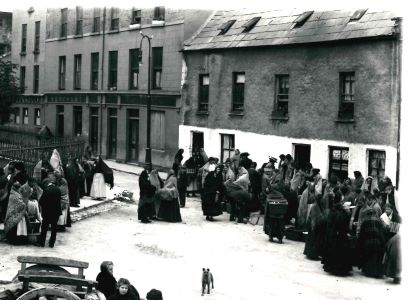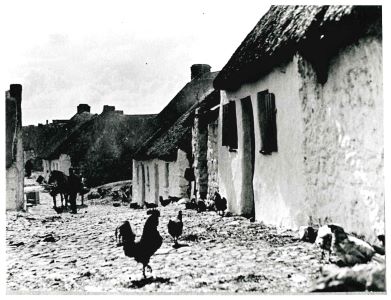Old Galway
THE ‘AMUSEMENTS’ IN THE FAIRGREEN

by Tom Kenny
It is good to see funfair being set up at the moment along the Prom, a sure sign that the summer is on the way. There has been a history of summer funfairs in Galway for well over a hundred years, though they were always known here as ‘the Amusements’. In the early days, the Toft family used to organise them in Salthill Park. Occasionally, the neighbours used to object to the noise and the traffic and on at least one occasion, they were invited next door on to the site in front of Dr. O’Beirne’s house (where Leisureland is today).
THE EGG AND BUTTER MARKET IN CHURCH STREET

by Tom Kenny
Some weeks ago we wrote about the virtues of country butter being sold at the Saturday Market, but it seems there were occasional vices there too. The ink was hardly dry on the paper when David Barrett sent us an account of a court case that took place at the Galway Petty Sessions in September 1910 before the magistrates Messrs. J. Kilbride and J.S. Young. District Inspector Hildebrand, prosecuted Mrs. Sarah Bane, Moycullen on three different counts of selling butter that was unfit for human consumption to Kate Hoare, Mary Griffin and Norah Joyce. Mr. Cooke, from Blake and Kenny solicitors, appeared for the defence.
CLAY PIPES AND DÚIDÍNS

by Tom Kenny
In the days before cigarettes were invented, clay pipes were very popular and could be found in most houses in the country. They were mainly used by working class people, easy to purchase, mass produced, cheap and light and smoked by men and women. The short stemmed version was known as a dúidín or dudeen in Ireland, as a cutty in Scotland and a ‘nose warmer’ in England. The longer version was known as the Beannacht Dé pipes or ‘The Lord ha’ mercy’ pipe, as that was how people invariably responded when you gave them one, “Beannacht Dé Leat”.
REILLY’S HOTEL, SALTHILL

by Tom Kenny
This small hotel owned by Mrs. B. O’Sullivan was prominently situated in Salthill (near where Seapoint is today), fully licensed, hot and cold running water in all bedrooms and had a large bungalow in the grounds at the back.
On May 14th 1921, John Green, a student from Sligo was staying there sharing a room with Patrick McDonagh and Gerald Hanley. James Egan, an insurance inspector from Mayo was also staying. On this night, the three in the room were in bed when they heard shots downstairs, then two RIC men, quite drunk, came into the room, talked amicably for a while, then left but fired about a dozen shots back through the bedroom door. Obviously they were confused by drink and came back and dragged Green and Hanley out in their pyjamas. As Green toppled down the stairs, he found James Egan lying in his own blood.
MAY SUNDAYS IN MENLO

by Tom Kenny
“Boats from the Long Walk as well as the Boraholla boats were plying, and the shouting of the boatmen “Who’s for Menlo, twopence a head, children free” rent the air … It is a slow voyage but no-one minds. Joe Banks, piper to the King plays ‘The Rakes of Mallow. Joe Kelly is piping in another boat, which is occupied by the Mayor of Galway … Sweet vendors were working night and day preparing sugar-sticks and kiss-pipes which were sold in colours of red and white at a half-penny each … the cries of different vendors of eatables and drinks rent the air: ‘Cider a penny a glass … The real juice of the American apple; Guinness threepence per pint and minerals twopence per bottle’ is the shout … Puritans and temperance fanatics were unknown … The ladies in the enclosure, which was at this side of the Castle, with their sunshades and costumes of mid-Victorian days, looked beautiful. The villagers and colleens with their shoulder-shawls and neat pinafores were a picture of neatness and comeliness. They were all dressed – not undressed as they are today. Lady Blake hands the prizes and cups to the successful crews. The Miss Blakes are chatting in good old Irish to Maureen, Shawneen and Paudeen.”
CALLING ALL SALERNO GIRLS

by Tom Kenny
The words of the late John O’Donohue: “The beginning often holds the clue to everything that follows,” could be said to be prophetic if applied to the date of May 1st, 1952 in Salthill. On that day, the courageous Sisters of Jesus and Mary opened a National school in what had been a small hotel known as Dalysfort House or Allen’s Hotel in Árd na Mara. They called it Scoil Íde and had 43 pupils. I don’t know if the teachers, Sisters Immaculata and Celine had any idea of what kind of impact that beginning would make on education and social life in Galway, but if they had, it would have been beyond their wildest dreams.
COUNTRY BUTTER IN THE MARKET

by Tom Kenny
There was nothing quite like the first bite and creamy taste of hand-churned country butter whether it was oozing and melting on your potatoes or spread on your bread. It was usually made in small batches, was rich and flavoursome and had an old fashioned taste, the way butter used to taste years ago.
CLADDAGH PARADE, c.1910

by Tom Kenny
An article that appeared in the Irish Times on January 7th 1861 was lifted from the Galway Press and started as follows: “Twenty years ago, this fishing village, for which outdoor relief is now deemed necessary, was the greatest source of profit and employment to the people of Galway. It was the wealth producing quarter of the town, and not alone the town of Galway, but many parts of the interior of Ireland felt the benefit of the successful industry of the Claddagh fishermen. The harvest fishing season, which began in August and ended in November, produced a very large accession of wealth to the country. The number of cadgers leaving the town for the interior averaged about 150 daily, and whilst these peripatetic dealers in fish were thus numerously employed, the foremost merchants we had were occupied in filling their stores with herrings, and even the Fishery Board on some occasions were known to barrel large quantities. So abundant frequently was the take that all the cargoes of salt provided by the importers of that article did not suffice, and it had to be brought overland from Limerick and other places”.
.png)